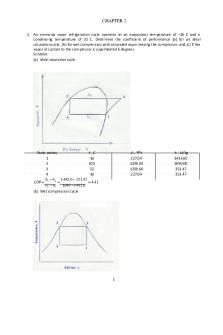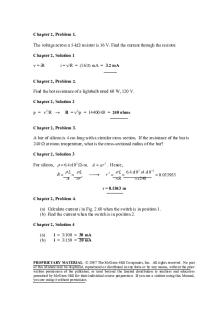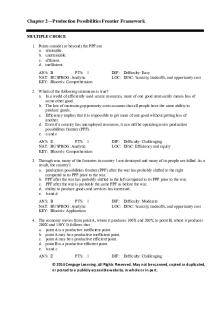Chapter 02 PDF

| Title | Chapter 02 |
|---|---|
| Author | Hoor Jasim Mohamed |
| Course | chemistry |
| Institution | جامعة الشارقة |
| Pages | 13 |
| File Size | 468.5 KB |
| File Type | |
| Total Downloads | 84 |
| Total Views | 168 |
Summary
practice...
Description
Chapter 2 -- Alkanes and Cycloalkanes MULTIPLE CHOICE 1. What is the molecular formula of an alkane that has fourteen carbon atoms? A) C14H28 B) C14H30 C) C14H32 D) C14H34 E) C14H26 ANS:
TOP: Alkane Nomenclature and Structural Formulas
2. What is the molecular formula of a cycloalkane that has six carbon atoms? A) C6H12 B) C6H14 C) C6H16 D) C6H10 E) C6H7 ANS:
TOP: Alkane Nomenclature and Structural Formulas
3. What is the name of the alkane that has three carbon atoms? A) methane B) ethane C) propane D) butane E) isobutane ANS:
TOP: Alkane Nomenclature and Structural Formulas
4. The correct IUPAC name for the following molecule is:
A) B) C) D) E)
6-ethyl-3,4,-dimethylheptane 2-ethyl-4,5-dimethylheptane 3,4,6-trimethyloctane 3,5,6-trimethyloctane none of these
ANS:
TOP: Alkane Nomenclature and Structural Formulas
5. What is the common name for the following molecule?
A) B) C) D) E)
isobutyl bromide tert-butyl bromide butyl bromide sec-butyl bromide bromo-sec-butane
ANS:
TOP: Alkane Nomenclature and Structural Formulas
6. The name of the alkyl group that contains three carbons is: A) methyl B) ethyl C) propyl D) isopropyl E) none of these ANS:
TOP: Alkane Nomenclature and Structural Formulas
7. Which of the following structures is 2-methylpentane? A) B)
C)
D)
E)
ANS:
TOP: Alkane Nomenclature and Structural Formulas
8. The name of the alkyl group below is:
A) B) C) D)
ethyl propyl isopropyl butyl
E) isobutyl ANS:
TOP: Alkane Nomenclature and Structural Formulas
9. What is the IUPAC name for the following compound?
A) B) C) D) E)
isohexyl bromide 3-bromo-4-methylpentane 1-bromopropylpropane 3-bromo-2-methylpentane 2-methyl-3-bromopentane
ANS:
TOP: Alkane Nomenclature and Structural Formulas
10. The IUPAC name for the following molecule is:
A) B) C) D) E)
2-chloro-3-ethyl-6,6-dimethylheptane 6-chloro-5-ethyl-2,2-dimethylheptane 6-chloro-2,2-dimethyl-5-ethylheptane 2,2-dimethyl-5-chloroethylheptane 6-chloro-5-ethyl-2-dimethylheptane
Ans
TOP: Alkane Nomenclature and Structural Formulas
11. The IUPAC name for the following molecule is:
A) B) C) D) E)
2-ethyl-4-methylpentane 4-methyl-2-methylpentane 2,4-dimethylhexane 1-isopropyl-2-methylbutane 2,4-methylhexane
ANS:
TOP: Alkane Nomenclature and Structural Formulas
12. What is a correct name for the following molecule?
A) B) C) D) E)
2,2-dichlorocyclopropane 1,1-dichlorocyclopentane 1,1-dichloropropane trans-1,1-dichlorocyclopropane 1,1-dichlorocyclopropane
ANS: E
TOP: Alkane Nomenclature and Structural Formulas
13. Trans-1-bromo-3-methylcyclobutane is represented by which structure below? A)
B)
C)
D)
E)
ANS:
TOP: Alkane Nomenclature and Structural Formulas
14. What is the correct name for the following cycloalkane?
A) B) C) D) E)
bromoethylcyclohexane trans-1-ethyl-3-bromocyclohexane cis-3-bromo-1-ethylhexane 1-bromo-3-ethylcyclohexane cis-1-bromo-3-ethylcyclohexane
ANS:
TOP: Alkane Nomenclature and Structural Formulas
15. The correct IUPAC name for (CH3)2CHCH(CH3)(CH2)3CH(CH3)2 is A) diisopropylpentane. B) 1,1,2,6,6-pentamethylhexane. C) 2,5-diisopropylpentane. D) 2,3,7-trimethyloctane. E) 1,4-diisopropylpentane. ANS:
TOP: Alkane Nomenclature and Structural Formulas
16. The correct IUPAC name for
A) B) C) D) E)
1,3,3-trimethylcyclobutane. cis-1,3,3-trimethylcyclobutane. trans-1,3,3-trimethylcyclobutane. 1,1,3-trimethylcyclobutane. 2,2,4-trimethylcyclobutane.
ANS:
TOP: Alkane Nomenclature and Structural Formulas
17. The structural formula for 2,2,3-trimethylhexane is A)
B)
C)
is:
D)
E)
ANS
TOP: Alkane Nomenclature and Structural Formulas
18. Which of the following would exhibit hydrogen bonding? A) CH3Cl B) CH3OH C) CH4 D) CH2Cl2 E) CH3CH3 ANS:
TOP: Alkane Properties
19. Which of the following alkanes would have the highest boiling point? A) pentane B) 2-methylbutane C) 2,2-dimethylpropane D) hexane E) 2-methylpentane ANS:
TOP: Alkane Properties
20. What statement does NOT apply to the boiling points of alkanes? A) The boiling point increases as the length of the carbon chain increases. B) Straight chain alkanes have a higher boiling point than their branched isomers. C) Because they are nonpolar, alkanes have lower boiling points than other organic
compounds of similar molar mass. D) The boiling points are affected by Van der Waals attractions. E) The boiling points are influenced by hydrogen bonding. ANS:
TOP: Alkane Properties
21. Which cycloalkane has the highest boiling point? A) cyclopropane B) cyclobutane C) cyclopentane D) cyclohexane E) cyclooctane ANS:
TOP: Alkane Properties
22. The boiling points of normal alkanes A) rise as the length of the carbon chain increases. B) rise as the length of the carbon chain decreases. C) are higher than the boiling points of branched alkanes with the same molecular
formula. D) a and c E) b and c ANS:
TOP: Alkane Properties
23. The most stable conformation of propane is: A) staggered B) chair C) planar D) eclipsed E) boat ANS:
TOP: Conformations of Alkanes
24. The least stable conformation of propane is: A) staggered B) chair C) planar D) eclipsed E) boat ANS:
TOP: Conformations of Alkanes
25. The preferred conformation of butane is given by which of the following Newman projection
formulas? A)
B)
C)
D)
E)
ANS:
TOP: Conformations of Alkanes
26. The least stable conformation of butane is given by which of the following Newman
projections? A)
B)
C)
D)
E)
ANS:
TOP: Conformations of Alkanes
27. The preferred conformation of cis-3-tert-butyl-1-methylcyclohexane is the one in which: A) the t-butyl group is axial and the methyl group is equatorial
B) C) D) E)
both groups are axial both groups are equatorial the methyl group is axial and the t-butyl group is equatorial molecule exists in a boat conformation
ANS:
TOP: Conformations of Cycloalkanes
28. The bond angle of a normal, tetrahedral, sp3 hybridized carbon is 109.5°. What is the C–C–C
bond angle of cyclobutane? A) 60° B) 90° C) 109.5° D) 120° E) 180° ANS:
TOP: Conformations of Cycloalkanes
29. For the most stable conformation of cis-1,3-dimethylcyclohexane: A) both methyls will occupy the axial position B) both methyls will occupy the equatorial position C) one methyl will occupy the axial position and the other an equatorial position D) more than one answer is correct ANS:
BTOP: Conformations of Cycloalkanes
30. Which of the following pairs are examples of conformational isomerism? A) chair and boat forms of cyclohexane B) 1-iodopropane and 2-iodopropane C) sec-butyl chloride and butyl iodide D) cis and trans-1,2-dimethylcyclohexane E) all of these ANS:
TOP: Conformations of Cycloalkanes
31. Consider this chair conformation:
When the ring flips, A) the bromine becomes axial and the methyls become equatorial. B) all three substituents become equatorial. C) the bromine becomes equatorial and the methyls become axial. D) the ring opens up. E) one methyl becomes axial, one becomes equatorial, and the bromine becomes equatorial.
ANS:
TOP: Conformations of Cycloalkanes
32. Consider this chair conformation:
A) B) C) D) E)
The methyl and bromine are cis and the chlorine and bromine are cis. The methyl and bromine are trans and the chlorine and bromine are cis. The methyl and chlorine are trans and the methyl and bromine are cis. The methyl and chlorine are trans and the methyl and bromine are trans. The methyl and chlorine are trans and the bromine and chlorine are cis.
ANS:
TOP: Conformations of Cycloalkanes
33. Cycloalkanes with A) 2 B) 3 C) 4 D) 5 E) 6 ANS:
or more carbons in the ring are nonplanar.
TOP: Conformations of Cycloalkanes
34. 1-Bromopropane and 2-bromopropane are A) constitutional isomers. B) homologs. C) configurational isomers. D) conformational isomers. E) stereoisomers. ANS:
TOP: Isomerism
35. The compounds represented by the structures below are:
A) B) C) D) E)
structural isomers. identical. cis-trans isomers. conformers. constitutional isomers.
ANS:
TOP: Isomerism
36. The compounds represented by the structures below are:
A) B) C) D) E)
structural isomers. different compounds. cis-trans isomers. conformers. constitutional isomers.
ANS:
TOP: Isomerism
37. The compounds represented by the structures below are:
A) B) C) D) E)
structural isomers. different compounds. cis-trans isomers. conformers. constitutional isomers.
ANS:
TOP: Isomerism
38. The compounds represented by the structures below are:
A) B) C) D) E)
constitutional isomers. identical. cis-trans isomers. conformers. different compounds (not isomers)..
ANS:
TOP: Isomerism
39. In the chlorination of methane, the propagation steps involve forming: A) H radicals B) methyl radicals C) chlorine radicals D) a, b, and c E) b and c ANS:
TOP: Reactions of Alkanes
40. How many monobromo products can be obtained from the bromination of cyclopentane? A) 1 B) 2 C) 3 D) 4 E) 5 ANS:
TOP: Reactions of Alkanes
41. How many isomeric dichloro products can be obtained from the chlorination of cyclopropane? A) 1 B) 2 C) 3 D) 4 E) 5 ANS:
TOP: Reactions of Alkanes
42. The number of possible monobromination products, including cis-trans isomers, of
methylcyclopentane is A) 2 B) 3 C) 4 D) 5 E) 6 43. The number of possible dibromination products of 2-methylpropane is A) 2 B) 3 C) 4 D) 5 E) 6 44. The number of possible dichlorination products of propane is A) 2 B) 3 C) 4 D) 5
E) 6 ANS: C
TOP: Reactions of Alkanes...
Similar Free PDFs

Chapter 02
- 13 Pages

Chapter 02
- 10 Pages

Chapter 02
- 47 Pages

Chapter 02
- 14 Pages

Ross12e Chapter 02 TB
- 19 Pages

Chapter 02-vectorist
- 66 Pages

Chapter 02 - TEST BANK
- 12 Pages

Chapter 02 - Exercise
- 36 Pages

Chapter 02 answerkey
- 32 Pages

Chapter 02 - testbank
- 19 Pages

Exam View - Chapter 02
- 8 Pages

Chapter 02- Economic Models
- 78 Pages

Chapter 02 INACC
- 60 Pages

Chapter 02 Quizzes
- 4 Pages

Chapter 02 - summary
- 14 Pages

ISM Chapter 02
- 14 Pages
Popular Institutions
- Tinajero National High School - Annex
- Politeknik Caltex Riau
- Yokohama City University
- SGT University
- University of Al-Qadisiyah
- Divine Word College of Vigan
- Techniek College Rotterdam
- Universidade de Santiago
- Universiti Teknologi MARA Cawangan Johor Kampus Pasir Gudang
- Poltekkes Kemenkes Yogyakarta
- Baguio City National High School
- Colegio san marcos
- preparatoria uno
- Centro de Bachillerato Tecnológico Industrial y de Servicios No. 107
- Dalian Maritime University
- Quang Trung Secondary School
- Colegio Tecnológico en Informática
- Corporación Regional de Educación Superior
- Grupo CEDVA
- Dar Al Uloom University
- Centro de Estudios Preuniversitarios de la Universidad Nacional de Ingeniería
- 上智大学
- Aakash International School, Nuna Majara
- San Felipe Neri Catholic School
- Kang Chiao International School - New Taipei City
- Misamis Occidental National High School
- Institución Educativa Escuela Normal Juan Ladrilleros
- Kolehiyo ng Pantukan
- Batanes State College
- Instituto Continental
- Sekolah Menengah Kejuruan Kesehatan Kaltara (Tarakan)
- Colegio de La Inmaculada Concepcion - Cebu